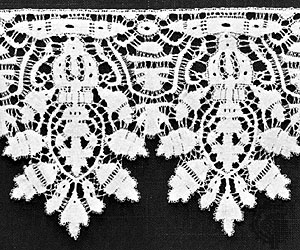bobbin lace
lacework
also called pillow lace, or bone lace
 with needle lace, one of two main kinds of lace. Bobbin lace is made with a number of threads, each fastened to an elongated spool (bobbin). A pattern is drawn on parchment or paper, and holes are pricked to indicate where pins will be placed to keep the threads in position while the lace is being made. The parchment is placed on a pillow or cushion, and the threads, with the bobbins hanging on them, are attached. The lace is worked with each hand holding a pair of bobbins, which are moved from side to side to form a twist, a braid, or a clothlike fabric called toile. The technique arose later than that of needle lace and derived from the practice of knotting fringes of material. The first bobbin lace probably originated in the early 16th century. The question of its place of origin—Italy or Flanders—has not been resolved, but most agree that it was probably developed in Flanders. The first weights were of lead, followed by other materials such as wood and bone (hence “bone lace”). Early bobbin lace consisted of rows of deep acute-angled points worked from a narrow band, and the patterns usually were similar to those of the needle laces. It was much used for ruffs and collars in the 16th and 17th centuries.
with needle lace, one of two main kinds of lace. Bobbin lace is made with a number of threads, each fastened to an elongated spool (bobbin). A pattern is drawn on parchment or paper, and holes are pricked to indicate where pins will be placed to keep the threads in position while the lace is being made. The parchment is placed on a pillow or cushion, and the threads, with the bobbins hanging on them, are attached. The lace is worked with each hand holding a pair of bobbins, which are moved from side to side to form a twist, a braid, or a clothlike fabric called toile. The technique arose later than that of needle lace and derived from the practice of knotting fringes of material. The first bobbin lace probably originated in the early 16th century. The question of its place of origin—Italy or Flanders—has not been resolved, but most agree that it was probably developed in Flanders. The first weights were of lead, followed by other materials such as wood and bone (hence “bone lace”). Early bobbin lace consisted of rows of deep acute-angled points worked from a narrow band, and the patterns usually were similar to those of the needle laces. It was much used for ruffs and collars in the 16th and 17th centuries.- J. Stuart Blackton
- J. Tuzo Wilson
- Juana de Ibarbourou
- Juan Antonio de Zunzunegui
- Juan Antonio Marichal
- Juan António, marqués de Samaranch Samaranch
- Juan António Samaranch, marqués de Samaranch
- Juan Bautista Alberdi
- Juan Bautista José Cabanilles
- Juan Bautista Sacasa
- Juan Belmonte
- Juan Benet Goitia
- Juan Bosch
- Juan Boscán
- Juan Carlos
- Juan Carlos Onetti
- Juan Carreño de Miranda
- Juan Crisóstomo Arriaga
- Juan de Austria
- Juan de Escobedo
- Juan de Fuca Strait
- Juan de Grijalba
- Juan de Herrera
- Juan de la Cierva
- Juan de la Cueva